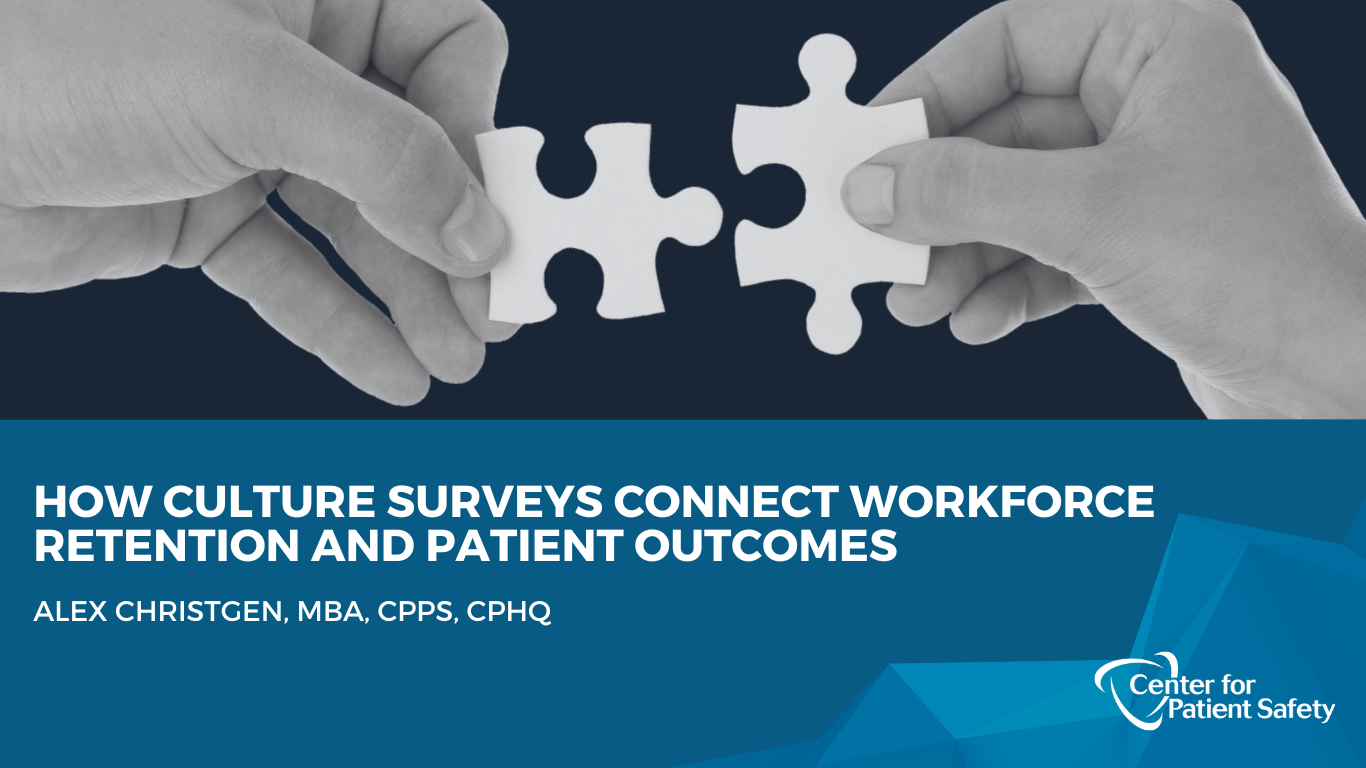How Culture Surveys Connect Workforce Retention and Patient Outcomes

A number of factors are coming together in the healthcare industry to create uncertainty and stress in our workforce and to ultimately threaten patient outcomes. For example:
- Mergers and acquisitions and other forms of organizational partnering literally reconstruct the framework upon which a staffing model is built.
- Artificial intelligence sits as a huge unknown on the horizon which may eliminate or substantially change some work.
- Areas like finance, billing, and supply chain are increasingly outsourced to improve efficiencies and reduce costs.
With the increase in price transparency, telehealth options, and expanding patient satisfiers like online bill pay, consumers are making more of their healthcare decisions based on price and convenience. An organization that adapts to meet these consumer requirements can position itself to retain consumer loyalty and therefore also, its future viability.
However, staffing challenges are the greatest obstacle to achieving sustainability and it is affecting almost everyone in healthcare today, impacting day-to-day operations to long-range planning.
- On the front line, employees report to work for their shift, then stay late, or work additional shifts to cover vacancies.
- Sometimes, there just aren’t enough bodies to do the work.
- Employees face increasing levels of hostility, resistance, and violence as they work, often from patients and families.
In the midst of all this, the quality of our patient care depends on having enough qualified staff members and reducing the churn.
Studies have demonstrated a correlation between high nurse staff turnover and poor patient outcomes. Disruption in the nursing ranks also decreases the satisfaction of other employees. As turnover increases, staff become more disengaged, burnout faster and more easily, and patient care deteriorates. Without strong patient care, the stability of a hospital is threatened. Coupling turnover insecurities with the increase in incivility and workplace violence in healthcare today, you’ve got a pot that is about to boil over.
Why is recruiting and retention so hard?
- Even with steady increases in med school graduates over the last two decades, there is an expected shortage of more than 100,000 physicians in the next decade.
- Nursing schools turned away over 90,000 qualified applicants from undergrad and graduate programs in 2021 alone due to a lack of educators and classroom space.
- Research indicates that, in the U.S., approximately half of health workers often feel burned out; and about two-thirds of nurses and 58% of physicians have symptoms of burnout, which is characterized as high emotional exhaustion, high depersonalization (i.e. cynicism), and a low sense of personal accomplishment.
- PreCovid research indicates 18.2% of U.S. healthcare workers were born outside of the U.S., as well as 29% of U.S. physicians and 15% of RNs. These numbers indicate recruitment and retention efforts must focus on appealing to a diverse group. The political firestorm around immigration will make it more difficult to recruit from abroad.
- And lastly, according to the Association of American Medical Colleges (AAMC) the first-year medical school class of 2021 is larger and more diverse than any class before it.
It is difficult to find trained and educated individuals who are willing and able to fill the demand; and the expectations for organizations to meet diverse needs are at a new high. This creates incredible value in retaining your current workforce and creating a culture that appeals to all new employees.
Did you know a safety culture survey is specifically designed to measure areas of your culture that influence internal employee retention by evaluating top concerns like burnout, turnover, communication, engagement, and even workplace safety from violence? These are all issues that, if not addressed, can deteriorate and drive employees out of their jobs and out of the industry workforce. Some, unable to see other options, choose suicide.
A safety culture survey can guide your retention and recruitment strategies by identifying strengths and weaknesses in your organization’s culture, boosting your ability to attract and retain diverse staff, focus on reducing burnout, and improve your patient outcomes.
An organization on the journey to improve their culture should consider these three questions:
- Has your organization done the survey before? Do you have historical data, did you have goals from the last survey and what’s been done to improve patient safety culture since then?
- Is this the right time to administer your next survey? Does your organization have committed and supportive leadership? Are your Mission, Vision, Values and Goals aligned? Do you have an improvement model in place? Are any other major events going to distract from the survey, such as the “go-live” of a new EMR?
- Has senior leadership determined they are ready to “hear” thoughts on patient safety from the frontline leaders and staff? Are they ready to support taking action?
Organizations that conduct a safety culture survey to check a box or simply to meet regulatory requirement will get limited benefit. The Joint Commission and Leapfrog usually request a minimum response rate. You may reach that easily the first time you survey, but if you don’t take action on the results and share the feedback and improvements with staff members who, feeling unheard and unappreciated, won’t see value in completing the survey next time. Increasing frustration may convince them to leave.
When administered with understanding and intentionality, the survey allows leaders to see many of the cultural factors that impact the staff. It prompts decision-makers to take a closer look at how values, beliefs, and practices impact the overall culture, paving the way for meaningful improvements and sustainable growth. Embracing the results and insights gained from a survey demonstrates openness, transparency, and continuous learning, ultimately enhancing the well-being of our workforce lending to retention and a higher quality of care provided to our patients.
Contact the Center for Patient Safety for more information about your organization’s readiness to complete a safety culture survey.
.png)